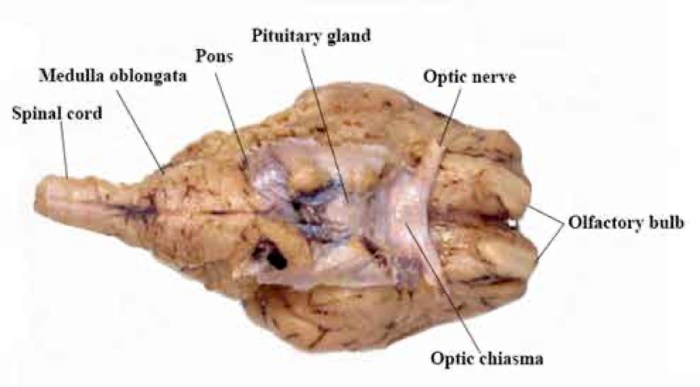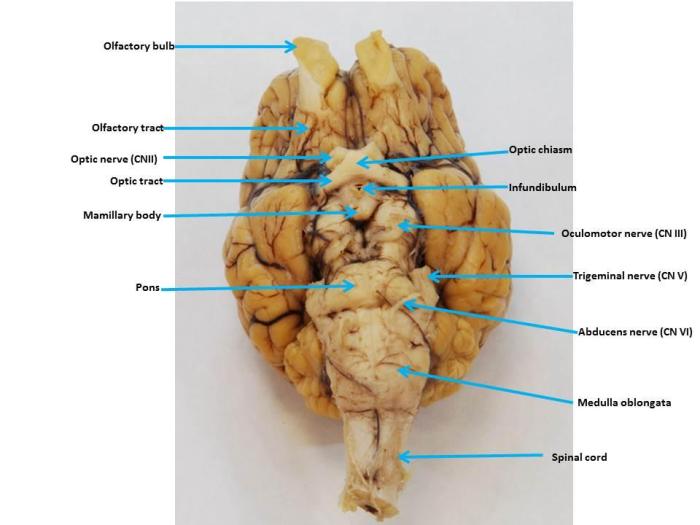Sheep brain ventral view labeled unveils the intricate architecture of the ovine brain, providing a foundation for understanding its neural circuitry and function. This guide embarks on a journey through the ventral surface of the sheep brain, dissecting its key anatomical landmarks, exploring its functional significance, and drawing comparisons to other mammalian brains.
The ventral view of the sheep brain presents a tapestry of structures, each playing a vital role in the coordination and execution of bodily functions. From the olfactory bulbs, responsible for our sense of smell, to the medulla oblongata, controlling vital life functions, this intricate landscape holds clues to the complexities of the nervous system.
Sheep Brain Ventral View: Overall Structure: Sheep Brain Ventral View Labeled

The ventral surface of the sheep brain, visible from below, presents a distinct organization and arrangement of anatomical structures. It provides insights into the brain’s overall architecture and the interconnections between various brain regions.
A labeled diagram of the sheep brain ventral view reveals key landmarks such as the olfactory bulbs, optic nerves, optic chiasm, cerebral peduncles, pons, and medulla oblongata. The brain is divided into two hemispheres by the longitudinal fissure, and the major lobes—frontal, parietal, temporal, and occipital—are separated by sulci (grooves) and gyri (ridges).
Forebrain Structures
The forebrain region on the ventral surface encompasses structures involved in sensory perception and processing.
- Olfactory bulbs:Located at the rostral end, they receive and process olfactory information from the nose.
- Optic nerves:These nerves transmit visual information from the eyes to the brain.
- Optic chiasm:A point where the optic nerves partially cross over, allowing for binocular vision.
Midbrain and Hindbrain Structures
The midbrain and hindbrain regions on the ventral surface contain structures involved in motor control, coordination, and vital functions.
- Cerebral peduncles:Thick bundles of nerve fibers connecting the forebrain to the midbrain.
- Pons:A bridge-like structure involved in relaying motor and sensory information, as well as respiratory control.
- Medulla oblongata:Continuous with the spinal cord, it regulates vital functions such as breathing, heart rate, and blood pressure.
Blood Supply and Vascularization
The ventral surface of the sheep brain receives blood supply from major arteries, including the carotid arteries and vertebral arteries. Veins, such as the jugular veins, drain blood from the brain.
The vascularization pattern of the ventral surface ensures adequate oxygen and nutrient supply to the brain’s structures.
Comparative Anatomy with Other Mammals
The ventral view of the sheep brain exhibits similarities and differences when compared to other mammals.
- Humans:The overall organization and major structures are comparable, but humans have a more complex cerebral cortex with expanded frontal lobes.
- Rodents:The olfactory bulbs are relatively larger in rodents, reflecting their reliance on olfaction.
Clinical Significance and Applications, Sheep brain ventral view labeled
Understanding the ventral view of the sheep brain is essential for:
- Veterinary medicine:Diagnosing and treating neurological disorders in sheep.
- Neuroscience research:Studying brain function, connectivity, and evolution.
FAQ Section
What is the function of the olfactory bulbs?
The olfactory bulbs are responsible for processing olfactory information, allowing us to perceive smells.
What is the role of the medulla oblongata?
The medulla oblongata controls essential life functions such as breathing, heart rate, and blood pressure.
